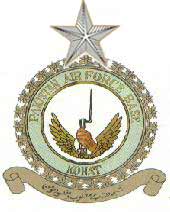|
PAF Base Kohat has had a long and active history which can be divided into two periods according to the role of the base i.e. pre and post independence periods.
The RAF commissioned this base for operational purposes in 1922 to meet the threat posed by tribesmen of the northern and western areas of the Frontier Province. Kohat was one of the three stations in the region, the other two being Peshawar and Risalpur. In the 20s, Kohat was The administrative wing, maintenance wing fighter-bomber base with two squadrons of Westland Wapitis - Nos. 27 and 60 RAF Squadrons. The Wapiti was a single-engine general purpose aircraft, powered by a Bristol Jupiter engine. It was rather small and carried a pilot and an air gunner. No 60 Squadron had a fine record in WW 1 Albert Ball, VC, was among its distinguished first combined graduation parade of members.
According to records available at the base, the headquarters building, aircraft and supply hangars, Ml room, armory, swimming pool and many other buildings were erected in 1925. Double storey barracks Nos 90 and 95, and living out JCOs' accommodation were built in 1940.
In 1938 there were two different squadrons at the station, Nos 16 and 17 with three flights each and with each flight comprising 8 aircraft. The aircraft were mainly Wapitis and Audaxes, with a few Blenheims. All pilots and airmen were British. The runway was a rectangular grass field divided into four equal parts, each of which was irrigated in turn. The present ATC building was called 'watch office' and lamps like the ones carried by railway guards used to be placed along the runway for night flying. The electric power supply was DC and used to be drawn from the MES power house situated behind the CMH. No 16 Gorkha Regiment used to guard the base at night .
The runway was extended in 1939 for which the main hangar (No 28) had to be dismantled and rebuilt at the present SEM classes site. In the early-70s, the same hangar was moved to PAF Base Mianwali. The present supply squadron hangar was used as an aircraft workshop. The present catering flight used to be the airmen's mess while the small room in front of the present MI room was the catering flight. The station commander, Wing Commander Bray, lived in a bungalow on the premises of the officers' mess, now occupied by the SMO, and used to go to office in a horse drawn coach. Several officers had their own horses and played polo at the army brigade ground. Stables for the horses were built in the officers' mess compound. The officers used to wear trousers while the men wore shorts with stockings. The food was cooked separately for personnel of different religions but most of the cooks were Christians. During WW 11, several RAF and IAF squadrons staged through Kohat as part of their cycle of rest periods between deployments on the Burma front. Among those who commanded the station between 1939 and 1947 were IAF Wing Commanders Mukerjee, Mehr Singh, A M Engineer and Arjun Singh. On 19 December 43, General Sir C J E Auchinleck visited the station and inspected a guard of honour formed by IAF airmen. The General arrived from Thal in a Lodestar aircraft and was received at the aerodrome by the Commander Kohat District Major General C A Osborn, AOC No 223 RAF Group Air Commodore H J F Hunter and the Station Commander Wing Commander S Mukerjee.
In the post-independence period, Kohat was commanded only by Pakistani officers. The primary role of the station as a flying base was extended with the addition of a training function and this dual function lasted till the end of 1963. The last flying unit to operate regularly from Kohat, No 9 (Fury) Squadron ceased operations from this airfield in 1961. Thereafter, Kohat has remained primarily a training base. |


